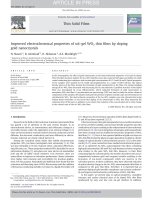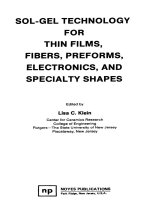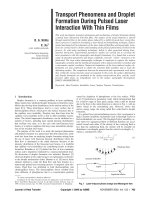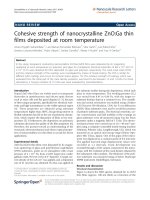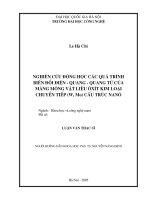Undoped and doped zno based thin films by a solution process preparation and characterization
Bạn đang xem bản rút gọn của tài liệu. Xem và tải ngay bản đầy đủ của tài liệu tại đây (3.74 MB, 72 trang )
VIETNAM NATIONAL UNIVERSITY, HANOI
VIETNAM JAPAN UNIVERSITY
LE THI HIEN
UNDOPED AND DOPED ZNO – BASED THIN FILMS BY A
SOLUTION PROCESS: PREPARATION AND CHARACTERIZATION
MASTER’S THESIS
Ha Noi, 2019
VIETNAM NATIONAL UNIVERSITY, HANOI
VIETNAM JAPAN UNIVERSITY
LE THI HIEN
UNDOPED AND DOPED ZNO – BASED THIN FILMS BY A
SOLUTION PROCESS: PREPARATION AND CHARACTERIZATION
MAJOR: NANOTECHNOLOGY
CODE: PILOT
SUPERVISOR:
Senior lecturer Dr. Bui Nguyen Quoc Trinh
Ha Noi, 2019
ACKNOWLEDGMENTS
First of all, I would like to send special thanks to my supervisor, Dr. Bui
Nguyen Quoc Trinh, a Senior Lecturer at University of Engineering and
Technology and Vietnam Japan University, Vietnam National University in Hanoi,
for supporting a great academic environment, helpful advices and strong
motivations, which should be an inspiration for me, now and future. He always
encourages me in doing experiments, in thinking physical meanings independently,
and in writing the thesis.
Second, apart from my supervisor in Vietnam, I am grateful to Prof. Akihiko
Fujiwara at Department of Nanotechnology for Sustainable Energy, Kwansei
Gakuin University in Japan, for his unforgettable supports to my internship
program. Also, I am thankful to MSc. Nguyen Quang Hoa at VNU Hanoi
University of Science for X-ray diffractormeter measurement and scanning electron
microscope observation.
Third, I would like to thank all faculty members of Nanotechnology Program,
Vietnam Japan University, Vietnam National University for teaching and helping
me within 2-year master course.
Last but not least, my profound gratitude would be expressed to my parents,
sisters, brother, and friends, because of their unconditional loves when facing
difficulties in completion of master degree and whole life.
This thesis is supported by the research project in 2019 from Vietnam Japan
University (VJU), Research Grant Program of Japan International Cooperation
Agency (JICA), and the project No. QG.19.02 of Vietnam National University,
Hanoi.
i
TABLE OF CONTENTS
ACKNOWLEDGMENTS........................................................................................... i
TABLE OF CONTENTS ........................................................................................... ii
LIST OF FIGURES.....................................................................................................v
LIST OF TABLES ................................................................................................... vii
LIST OF ABBREVIATIONS ................................................................................. viii
ABSTRACT ................................................................................................................1
INTRODUCTION .......................................................................................................2
CHAPTER 1. LITERATURE REVIEW ....................................................................4
1.1. Overview of ZnO material ................................................................................4
1.1.1. Crystal structure .........................................................................................4
1.1.1.1. Wurtzite structure.................................................................................6
1.1.1.2. Zinc blende structure............................................................................7
1.1.1.3. NaCl structure (Rocksalt) ....................................................................7
1.1.2. Energy bandgap structure of ZnO ..............................................................8
1.1.3. Properties of Zinc Oxide ............................................................................8
1.1.3.1. Electrical property ................................................................................8
1.1.3.2. Optical properties .................................................................................9
1.2. Techniques of thin films preparation ..............................................................10
1.2.1. Vacuum processes ....................................................................................10
1.2.1.1. Sputtering method ..............................................................................10
1.2.1.2. Pulse laser deposition .........................................................................11
1.2.2. Non-vacuum processes .............................................................................12
1.2.2.1. Chemical vapor deposition (CVD) ....................................................12
ii
1.2.2.2. Chemical bath deposition (CBD) .......................................................12
1.2.2.3. Sol-gel ................................................................................................12
1.3. Potential applications ......................................................................................13
1.4. Thesis target ....................................................................................................13
CHAPTER 2. EXPERIMENTAL PROCEDURES ..................................................15
2.1. Precursor solutions ..........................................................................................15
2.1.1. Preparation of precursor solutions ...........................................................15
2.1.2. Precursor processing.................................................................................16
2.2. Thin films deposition ......................................................................................18
2.2.1. Tool and equipment ..................................................................................18
2.2.2. Thin films fabrication ...............................................................................18
2.3. Thin films characterization .............................................................................19
2.3.1. X-ray Diffractometer ................................................................................19
2.3.2. Four- probe measurement systems ...........................................................25
2.3.3. UV-Vis Spectroscopy ...............................................................................26
CHAPTER 3. RESULTS AND DISCUSSION ........................................................29
3.1. Analysis on structural property .......................................................................29
3.1.1. Effect of Cu doping concentration ...........................................................29
3.1.2. Effect of annealing temperature ...............................................................32
3.2. Analysis on morphological micrographs ........................................................35
3.2.1. Effect of Cu doping concentration ...........................................................35
3.2.2. Effect of annealing temperature ...............................................................38
3.3. Physical characterization ................................................................................40
3.3.1. Optical property ........................................................................................40
iii
3.3.1.1. The effect of Cu doped concentration ................................................40
3.3.1.2. Effect of annealing temperature .........................................................44
3.3.2. Electrical property ....................................................................................50
3.3.2.1. The effect of Cu doped concentration ................................................50
3.3.2.2. The effect of annealing temperature ..................................................51
CONCLUSIONS .......................................................................................................53
REFERENCES ..........................................................................................................54
iv
LIST OF FIGURES
Page
Figure 1.1. Three crystal structures of ZnO [6]. ........................................................5
Figure 1.2. Wurtzite structure. ...................................................................................6
Figure 1.3. Schematic of a Wurtzitic ZnO structure. .................................................6
Figure 1.4. Schematic representation of a Zinc blende. .............................................7
Figure 1.5. Schematic representation of a NaCl (Rock salt). .....................................7
Figure 1.6. Energy bandgap structure of ZnO [4]. .....................................................8
Figure 1.7. Sputter deposition. .................................................................................11
Figure 1.8. Pulsed laser deposition. .........................................................................11
Figure 1.9. Sol- gel process. .....................................................................................13
Figure 2.1. Zn(CH3COO)2.H2O]. .............................................................................15
Figure 2.2. Cu(CH3COO)2.H2O]. .............................................................................15
Figure 2.3. Ethanol. ..................................................................................................16
Figure 2.4. Mono Ethanol Amine.............................................................................16
Figure 2.5. Hotplate. .................................................................................................16
Figure 2.6. Analytical balance..................................................................................16
Figure 2.7. Process of making precursor solution. ...................................................18
Figure 2.8. Thin films fabrication. ...........................................................................19
Figure 2.9. Bragg-Brentano XRD geometry. ...........................................................21
Figure 2.10. Glancing incidence geometry. .............................................................21
Figure 2.11. Glancing incidence XRD and conventional XRD. The sample is a thin
film of metal on glass [26]. .......................................................................................22
Figure 2.12. X-ray diffractometer (XRD, Bruker, D5005) ......................................22
Figure 2.13. Schemantic representation of the basic SEM components. .................23
Figure 2.14. Scanning electron microscope (SEM, Nova NANOSEM 450). ..........25
Figure 2.15. Schematic of four-point probe configuration. .....................................26
Figure 2.16. Schematic of a conventional spectrophotometer. ................................28
v
Figure 3.1. XRD patterns with various Cu doped concentrations: 0%, 0.5%, 1%,
1.5% and 2%. ............................................................................................................29
Figure 3.2. XRD patterns of 0.5% Cu doping concentration, and temperarure
changed: 400, 450, and 500oC...................................................................................32
Figure 3.3. XRD patterns of 2% Cu doping concentration, and temperarure
changed: 400, 450, and 500oC...................................................................................34
Figure 3.4. SEM graph of CZO thin film with 0% Cu doped concentration. ..........35
Figure 3.5. SEM graph of CZO thin film with 0.5% Cu doped concentration. .......36
Figure 3.6. SEM graph of CZO thin film with 1% Cu doped concentration. ..........36
Figure 3.7. SEM graph of CZO thin film with 1.5% Cu doped concentration. .......36
Figure 3.8. SEM graph of CZO thin film with 2% Cu doped concentration. ..........37
Figure 3.9. SEM graph of CZO thin film at 400oC, 0.5%........................................38
Figure 3.10. SEM graph of CZO thin film at 450oC, 0.5%......................................38
Figure 3.11. SEM graph of CZO thin film at 500oC, 0.5%......................................39
Figure 3.12. SEM graph of CZO thin film at 400oC, 2%.........................................39
Figure 3.13. SEM graph of CZO thin film at 450oC, 2%.........................................39
Figure 3.14. SEM graph of CZO thin film at 500oC, 2%.........................................40
Figure 3.15. The absorbance spectra of CZO with various Cu doped concentration:
0%, 0.5%, 1%, 1.5% and 2%. ...................................................................................41
Figure 3.16. The bandgap of CZO with various Cu doped concentration. ..............42
Figure 3.17. The transmission spectra with various Cu doped concentration: 0%,
0.5%, 1%, 1.5% and 2%. ...........................................................................................43
Figure 3.18. The absorbance spectra with various annealing temperatures, 0.5%. .45
Figure 3.19. The absorbance spectra with various annealing temperatures, 2%. ....46
Figure 3.20. The bandgap of CZO with various annealing temperatures, 0.5%. .....47
Figure 3.21. The bandgap of CZO with various annealing temperature, 2%. .........48
Figure 3.22. The transmission spectra with various annealing temperature, 0.5%..49
Figure 3.23. The transmission spectra with various annealing temperature, 2%.....50
vi
LIST OF TABLES
Page
Table 1.1. Characteristics of ZnO material at room temperature [6]. ........................5
Table 2.1. The mass of starting materials following Cu doped ZnO with different
doping concentrations. ..............................................................................................17
Table 3.1. The lattice parameter of CZO with various Cu doped concentration. ....31
Table 3.2. The lattice parameters of CZO with various annealing temperatures. ....34
Table 3.3. The lattice parameters of CZO with various annealing temperatures. ....35
Table 3.4. The bandgap energy and transmission of CZO thin films with various Cu
doped concentration at 500oC ...................................................................................44
Table 3.5. The bandgap energy and transmission of CZO thin films with various
annealing temperatures, and Cu doped concentration of 0.5%. ................................48
Table 3.6. The bandgap energy and transmission of CZO thin films with various
annealing temperatures, and Cu doped concentration of 2%. ...................................48
Table 3.7. The sheet resistance with various Cu doped concentrations. ..................51
Table 3.8. The sheet resistance with various annealing temperatures. ....................52
vii
LIST OF ABBREVIATIONS
CZO
Copper doped zinc oxide
CuO
Copper oxide
ZnO
Zinc oxide
MEA
Monoethanolamine
SEM
Scanning electronic microscope
XRD
X-ray diffraction
UV-Vis
Ultraviolet – Visible
viii
ABSTRACT
In this study, CZO thin films, whose doping concentrations varied at 0%,
0.5%, 1.0%, 1.5% and 2.0%, were successfully fabricated by using sol-gel method.
The annealing temperatures were 400oC, 450oC, and 500oC for all concentration
conditions. XRD results revealed that the preferential orientations of CZO thin
films are along with (100), (002) and (101). The best crystallization is corresponded
to dopant concentration of 0.5%, and annealing temperature of 500oC. SEM
observation indicates that the grain size is relatively uniform, but the surface
morphology is porous. Also, the grain size is inversely proportional to Copper (Cu)
doping concentration, but directly proportional to the annealing temperature.
Optical analysis points out that the CZO thin films absorb most strongly at
wavelengths ranged from 360 to 375 nm; and bandgap energy of CZO thin films
was in range of 3.13 - 3.23 eV. Further findings of CZO thin films are discussed in
detail in the thesis.
1
INTRODUCTION
Recently, semiconductor material Zinc Oxide (ZnO) has attracted many
research groups for three main reasons: first, ZnO has large exciton binding energy
of 60 meV; second, it has potential in optoelectronic applications because of its
wide direct bandgap is Eg = 3.3 eV at room temperature; third, ZnO requires a
simple crystal-growth technique, which might lower cost of the mass production. In
addition, ZnO consists of oxygen and zinc, which are popular metal in earth
resources, and lowers further price if commercialized [1].
ZnO has described that it is very resistant to high – energy radiation. It is
easily imprinted in all acids and alkalis, which provide an occasion for deposition of
small-size devices. Moreover, the crystal structure and lattice parameters of ZnO is
close to those of Gallium Nitrogenium, hence it can be used as a seed for epitaxial
growth of high-quality. Recently, ZnO has been considered for applications such as
transparent thin-film transistors, of which the defensive light exposure is reduced,
because ZnO layer is impervious to visible light [4]. It is interesting that, by
monitoring the concentration of doping material, ZnO is able to change: from
insulating through n-type semiconductor, and to metal, but optical transparency is
still maintained for transparent electrodes in flat-panel displays and light emitting
diode. Furthermore, ZnO is well known as a favorable contestant for spintronic
applications. Based on the dominant properties of ZnO as described above, a base
of Zinc Oxide with dopping Copper (CZO) has been fabricated in a thin film and
then characterized. At present, CZO is attracting a lot of attentions owing to its
potential to become p-type semiconductor layer.
CZO thin films to become p-type semiconductor, Zinc oxide based material is
usually doped with group I or V elements like: Copper, silver, nitrogen and
phosphorus. However, silver has stable valence but high cost, nitrogen and
phosphorus are cheap but have more unstable valences. While copper has only two
valances and it is low-cost material. Moreover, Copper and Zinc atomic sizes are
2
not very different. Therefore, copper has been selected for doping in ZnO
background to fabricate p-type semiconductor thin films.
In my study, ZnO thin film was fabricated on glass substrates by solution
process method to find out the optimum condition for doping concentration and
annealing temperature. Here, Zn2+ salt ion concentration in precursor solution is 0.5
M, and the molar ratio between Zn2+ salt and monoethanolamine is 1: 1. The
structural properties have been investigating. Thereby, this research aims to
investigate the effects of doping concentration and annealing temperature to find out
optimum condition of CZO thin films for high quality to application in the
electronic devices.
3
CHAPTER 1. LITERATURE REVIEW
1.1. Overview of ZnO material
Zinc Oxide (ZnO) is a II-VI compound semiconductor [2]. The ZnO
semiconductor has the bandgap energy of 3.37 eV and is an n-type semiconductor.
ZnO materials have a lot of properties such as good transmittance, high electron
mobility, wide bandgap, and strong luminescence at 300K [3].
ZnO is an important and hopeful material in numerous fields. It has notable
advantages over Copper Oxide (CuO) such as non-toxicity, low material costs,
simple fabricating procedure, chemical stability, high transparency in the visible
and near infrared spectral region, wide bandgap (Eg = 3.37 eV at 300 K), large
exciton binding energy (60 meV). Furthermore, its connected quantum well may
have 100% inside quantum efficiency and most of its dopants are gladly obtainable.
These benefits are of considerable interest for practical use in transparent
conductive films, solar cell, surface acoustic wave devices and gas sensing
applications [4-6].
1.1.1. Crystal structure
The crystal structure of ZnO is devided into three forms, Wurtzite structure,
Rocksalt structure and Zinc Blende structure. “Most of the group II–VI binary
compound semiconductors crystallize in either cubic zinc blende or hexagonal
Wurtzite (Wz) structure where each anion is surrounded by four cations at the
corners of a tetrahedron, and vice versa. This tetrahedral coordination is typical of
sp3 covalent bonding nature, but these materials also have a substantial ionic
character that tends to increase the bandgap beyond the one expected from the
covalent bonding. ZnO is a II–VI compound semiconductor whose ionicity resides
at the borderline between the covalent and ionic semiconductors” [3, 5].
4
(a). Rocksalt.
(b). Zinc blende.
(c). Wurtzite.
Figure 1.1. Three crystal structures of ZnO [6].
The typical crystal structures of ZnO is shown in Fig. 1.1, and they are
signified the Strukturbericht designations for the three phases.
Table 1.1. Characteristics of ZnO material at room temperature [6].
Parameter
Value
(T = 300K)
ao
0.32495 nm
co
0.52069
co/ ao
1.6021
Net weigh
5.6061 g/cm3
Durable phase at 300K
Wurtzite
Melting point
1975o
Dielectric constant
8.656
Bandgap energy
3.3 eV
Energy exciton
60 meV
Under ambient surroundings, the Wurtzite symmetry is the most
thermodynamically steady and has low crystallization temperature or activation
energy, whereas the Zinc blende ZnO structure can be stabilized only by growing
on cubic substrates, and the Rocksalt or Rochelle salt (NaCl) structure is obtained at
relatively high pressures. Furthermore, the Wurtzite structure has good electrical
5
and optical properties. Therefore, the Wurtzite crystal structure is the most
preferred.
1.1.1.1. Wurtzite structure
At room temperature, the Wurtzite structure has a hexagonal unit cell with
two lattice parameters a and c in the ratio of c/a = 1.633 and belongs to the space
group.
Figure 1.2. Wurtzite structure.
In each basic cell, the Wurtzite structure consists two molecules of ZnO. Zn
atoms are located at (0,0,0) and (1/3,1/3,1/3). O atoms are positioned at (0,0,u) and
(1/3,1/3,1/2+u). Each Zn atom will bind to 4 oxygen atoms located at the 4 vertices
of a tetrahedral [7, 8].
Figure 1.3. Schematic of a Wurtzitic ZnO structure.
6
1.1.1.2. Zinc blende structure
Figure 1.4. Schematic representation of a Zinc blende.
The Zinc blende structure is one of the two main structures of ZnO material.
In each basic cell of the Zinc, blende structure consists four molecules ZnO. Zn
atoms are positioned at (1/4,1/4,3/4), (1/4,3/4,3/4), (3/4,1/4,3/4), (3/4,3/4,1/4). O
atoms are located at (0,0,0), (0,1/2,1/2), (1/2,0,1/2), (0,0,1/2) [9].
1.1.1.3. NaCl structure (Rocksalt)
Figure 1.5. Schematic representation of a NaCl (Rock salt).
Rocksalt is a durable imitation of ZnO crystals in high pressure conditions
(10 Gpa). The lattice of rocksalt is similar to that of NaCl. In each basic cell, the
rocksalt structure consists of four molecules of ZnO [10].
7
1.1.2. Energy bandgap structure of ZnO
Figure 1.6. Energy bandgap structure of ZnO [4].
The ZnO material is a semiconductor with a direct wide bandgap, Eg = 3.37
eV, making it transparent for a large wavelength range in the solar spectrum [11].
1.1.3. Properties of Zinc Oxide
1.1.3.1. Electrical property
The electrical properties of ZnO thin films are influenced by two main
factors: the annealing temperature and the Cu doping concentration. The ZnO
crystal lattice is composed of cation Zn2+ and anion O2-. At room temperature, the
zinc and oxygen atoms in the lattice are usually closely linked. This explains why
ZnO has poor conductivity at room temperature. However, as the temperature
gradually increases to 400oC, the electrons affected by the temperature will become
more flexible and will be separated from the network nodes, forming the conductive
electrons and permitting the ZnO material to be conductive.
8
The electrical properties of ZnO are also affected by the doping
concentration. According to Ohm's law, the conductivity of the material is
calculated using the formula:
σ = n.μ.q
(1.1)
In this formula :
n is the charge carrier density
μ is the mobile particle loading flexibility
q is the electric charge
ZnO thin films are prepared by Sol-gel method. While not yet annealed, the
films have oxygen holes, which causes Zn to have two extra electrons. These two
electrons participate in the electrical conductivity procedure of ZnO materials.
However, the material in this case has no homogeneous microstructure; therefore,
the scattering process occurs strongly, which reduces the mobility μ, consequently
leading to reduce conductivity of ZnO materials. After performing the annealing
process in the air or oxygen-rich environment, due to the diffusion of oxygen into
the holes, the charge carrier density n decreases. However, the homogeneity of the
surface structure favours the mobility of the carriers, which enhances the
conductivity of ZnO material. If we choose the appropriate annealing temperature,
we can obtain ZnO thin films having not only good electrical conductivity but also
throughout property [11, 12].
1.1.3.2. Optical properties
Optical properties of a material depend on its bandgap energy structure and its
crystal lattice. The results from the spectral analysis of ZnO nano thin films pointed
out many drawbacks related to the emission of donor – acceptor pairs. The bandgap
energy structure is extended from 1.9 eV to 2.8 eV. The luminescence of ZnO thin
film in the blue light is not good because the existence of various impurities [13].
The optical properties of ZnO materials are expressed through the interaction of
9
electromagnetic waves with the surface of the material. When we put ZnO materials
under a light beam with a high level of energy, electrons will become more flexible
and move from the valence band to the conduction band. After existing in a steady
state in a period of time, electrons have a tendency to shift to lower energy levels.
This process releases an energy E = hf in the form of photons. ZnO materials are
transparent with the transmittance of approximately 80%. By studying their spectral
transmittance and absorbance spectrum, it is concluded that ZnO materials absorb
most strongly at wavelengths from 320 nm to 330 nm [14].
1.2. Techniques of thin films preparation
1.2.1. Vacuum processes
1.2.1.1. Sputtering method
RF-Magnetron Sputter is most effective in thin film fabrication technique.
Gas stream (usually argon or argon O2+, argon N2+) is injected the vacuum chamber
produces plasma that forms Ar + ions. These ions are directed to the target (metal to
create a thin film) which is negative. These ions moving at high velocity and
bombard the target and dislodge atoms from the target of target out. The atoms
"evaporating" and move on to substrate (glass or silicon wafer), accumulating on
substrate and forming thin films when the number of atoms is large enough. In the
process of sputtering, secondary ions increases the rate of film forming or reduce
the pressure on the target. This technique is magnetron sputtering.
It uses a
magnetic field to target. This magnetic field will keep the secondary electron knives
on the magnetic field lines around the target. The electrons oscillate near surface
target will contribute ionized argon atoms much more [13-19]. This speeds up the
process of creating thin films. The schematic of the sputtering system illustrating in
Fig. 1.7.
10
Figure 1.7. Sputter deposition.
1.2.1.2. Pulse laser deposition
“Pulse laser deposition offers various great benefits over other physical
deposition methods such as fast deposition time and compatibility with oxygen and
other inert gases” [18].
Figure 1.8. Pulsed laser deposition.
Pulse lase deposition method has been attracted in the past few years. This
method has successfully covered complex compounds [15, 16]. The Pulse laser
deposition technique was first used to fabricate the superconducting membrane
11
YBa2Cu3O7. Many materials are difficult to fabricate in normal methods but this
method has been successfully fabricated [17].
1.2.2. Non-vacuum processes
1.2.2.1. Chemical vapor deposition (CVD)
In the Chemical vapor deposition (CVD) method, vapor phase generated
enough reachable by chemical methods. Thin film coating is achieved by the
process of depositing atoms, molecules or ions through chemical reactions.
Chemical vapor deposition method is used to manufacture thin-film semiconductors
such as Si, AIIBVI, AIIIB, transparent conductive thin films like SnO2, In2O3: Sn
(ITO), dielectric thin films such as SiO2, Si3N4, BN, Al2O3 and metal thin films.
1.2.2.2. Chemical bath deposition (CBD)
Chemical bath deposition (CBD) is one among method useful for the
preparation of compound semiconductors from aqueous solutions. This technique is
extensively used to deposit buffer layers in thin film photovoltaic cells. The major
advantage of CBD is that it requires in its simplest form only solution containers
and substrate mounting devices. Chemical bath deposition yields stable, adherent,
uniform and hard films with good reproducibility by a relatively simple process.
1.2.2.3. Sol-gel
The sol-gel method is a highly flexible solution method for fabricating
materials such ceramics and inorganic metal oxides, in which the colloidal solution
“sol” is converted into phase “gel”. The materials used for preparing "sol" are
usually inorganic metal salts or metal organic compounds such as zinc acetate and
copper acetate. The application process for sol-gel forming various special shapes
obtained directly from the state associated with the control gel composition and
microstructure and low temperature processing [19]. The application process for
sol-gel forming various special shapes obtained directly from the state associated
with the control gel composition and microstructure and low temperature processing
[20, 21].
12
In recent years, more progress has been made in the development and
commercialization of this method. Nowadays it is one of the most pyromising
manufacturing techniques in nanotechnology. Spin coating is the most sol-gel
technique used fo preparation of thin film because of its simplicity, low cost, easy to
control chemical components, and large-fabrication scale [21-28].
Figure 1.9. Sol- gel process.
1.3. Potential applications
ZnO nanoparticles have many application in solar cell, transitor,
photocatalytic, photoluminescence, gas sensor, curved LED display and other
application. Regarding ZnO nanoparticle application in solar cells, Suliman et al.
reported the synthesis of ZnO nanoparticles with average diameter of 30 nm to
create ZnO films on transparent conductive glass (TCO), ZnO nanoparticles were
dissolved in ethanol and then applied on the TCO surface by the doctor blade
technique.
1.4. Thesis target
In theory, a material can not have both transparency and electrical
conductivity, which are proportional to each other because the conductivity is
proportional to the particle concentration n while the transmittance is inversely
proportional to n. However, some groups have successfully researched and
13
fabricated two materials with both benefits, that is, they have good conductivity and
transparent as well. Some are known as conductive polymers and conductive metal.
ZnO is one of special oxides among them. In order to increase the electrical
properties of the ZnO thin films, we apply the phase impurities. However, in order
not to lose the transparency of the material, the impurities must be mixed in a
suitable ratio. P-doped ZnO thin films are formed, when we perform acceptor
elements like N, Li, Ag, As, Cu. Cu doped ZnO thin films are being studied by
many research groups, and applied for a lot of specific applications in our life.
Moreover, ZnO has other great properties such as lighting in the ultraviolet and
visible light areas at room temperature, which can be used in frontiers such as: gas
sensors, biological sensor, solar cell. Nowadays, there are many different methods
to prepare ZnO thin films such as sputtering, electronic beam epitaxy, chemical
vapor phase deposition, electrochemical deposition, sol-gel. In this study, I used
sol-gel method to make Cu doped ZnO thin films because of simple and low-cost
prcess.
My research contents include:
Design and prepare ZnO and CuO precursor solution from Zinc (II) acetate, copper
(II) acetate monohydrate, monoethanolamine (MEA) and pure ethanol.
Optimize and fabricate Cu doped ZnO thin film by spin coating method.
Investigate and evaluate structural property, surface morphology as well as
electrical and optical properties of fabricated ZnO thin films.
14
CHAPTER 2. EXPERIMENTAL PROCEDURES
2.1. Precursor solutions
2.1.1. Preparation of precursor solutions
Instruments and chemical sources:
-
Copper (II) acetate monohydrate [Cu(CH3COO)2.H2O].
-
Zinc (II) acetate monohydrate [Zn(CH3COO)2.H2O].
-
Mono-ethanolamine (HOCH2CH2NH2, monoethanol amin).
-
Ethanol (C2H5OH, 99.7% purity).
-
Hotplate, analytical balance, and magnet stirrer.
The figures of instruments and chemical are shown as below.
Figure 2.1. Zn(CH3COO)2.H2O].
Figure 2.2. Cu(CH3COO)2.H2O].
15

